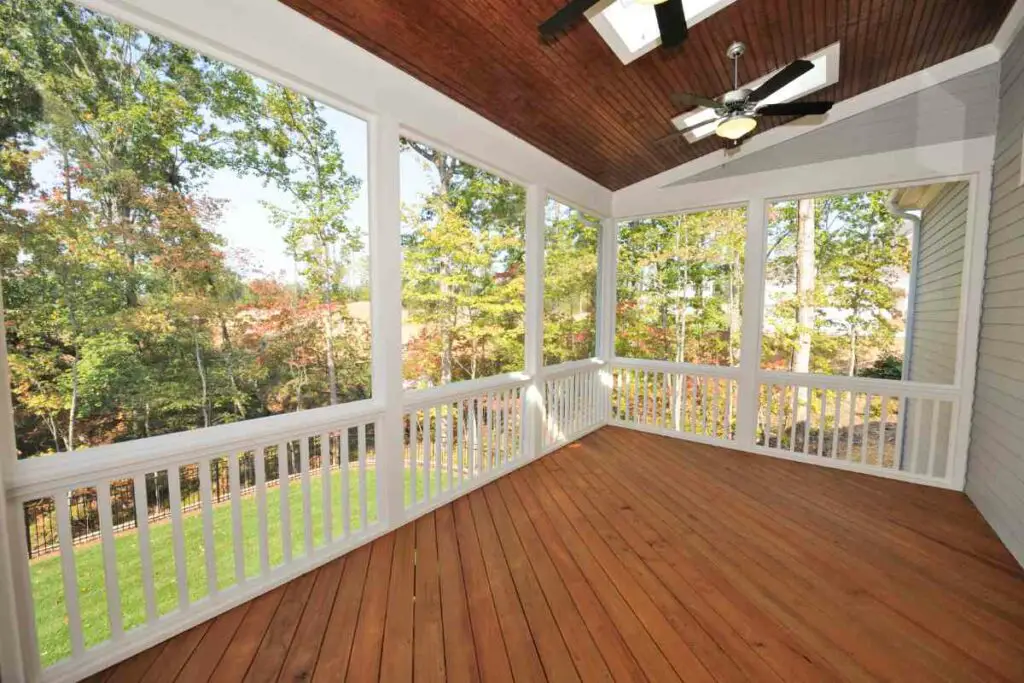There are laws about building patios in California that you’ll need to follow. The law requires no doors, windows, or other openings to be wider than six feet where your patio cover connects to your house. Patio covers should also have an area smaller than 120 sq ft.
Before building any patio, you’ll need to understand the rules and get the required permits. Otherwise, you could get fined and would have to deal with removing the patio.

Table of Contents
What Is The CA Law About Building Patios?
In California, you’ll need a building permit to add nearly any structures to your property, including patios. There are very few conditions where you won’t need to get one since your patio will be a permanent fixture on your property.
The same rules apply whether you’re using concrete or pavers to build the new patio, as long as it’s over 120 square feet.
What Are The Structural Laws For Patio Covers In CA?
Most places will have similar laws for building your patio and patio cover. International building codes say the cover should be able to hold dead loads (constant weight) and live loads (changing weight) up to set amounts.
It’s crucial the structure doesn’t block any openings to the outside and allows ventilation to continue as normal into your home. That way, in an emergency, you can still easily escape. Specifically, your new patio cover shouldn’t block the doors and windows. It can be a substantial fire code violation if it does.
Lastly, you can only use the patio cover’s enclosed area for “recreational purposes,” according to the laws. You can’t turn it into a bedroom, storage, or garage. If you want those additions, you’ll need to construct them and obtain different permits.
How Close to the Property Lines Can I Put a Patio in CA?
You’ll need to measure carefully while building your patio. It should be at least five feet from the property line.
If you need to determine where your property lines are, you should wait to build the patio until after you’ve met with a land surveyor. These professionals receive licenses through the State of California, so they have the proper certifications to ensure you know where the correct boundaries are.
Otherwise, you could accidentally construct your new patio too close to your neighbor’s property, which may result in fines. Building it too close to city property will also cost you, so you must know where you can build it.
Does It Matter Where I Build the Patio on My Property?
California also has specific laws regarding where the patio is on your property. Code 15.14.050 refers to yard structures (patios and decks) and patio covers; in this code, where you place the patio on your property matters.
For rear and side yards, structures taller than six feet must be at least three feet from the property lines and not taller than 12 feet. According to building and fire code limits, structures shorter than six feet can go up the property lines. Keeping it at least five feet from any property line is generally better, so you don’t break any rules.
If you’re building the patio in your front yard, it’s not allowed to be higher than six feet, so you can’t put an enclosure on it. It also needs to be at least three feet away from the property line, but again you should try for at least five feet.
Lastly, there’s a rule that drainage from your roof can’t run onto your new structure. You may also need to rearrange your home’s rain drainage system because of it. However, you won’t need to worry about the water eroding your patio, which would cause damage.

Will I Need Permission To Build a Patio in CA?
First, you’ll need to know if you need a permit. In most cases, you will need a permit to make a patio in California. According to California’s 2022 Building Code, Section 106.3(15) states that you’ll need a permit if:
- You’re pouring concrete for a platform less than 30 inches high
- You’re adding a patio cover
- The concrete platform doesn’t cover a basement or another story of the building
- The concrete goes outside of your property and into city property
- There are changes in elevation that are more than five feet between grades
Additionally, you’ll need a permit if you’re building an enclosed patio larger than 120 square feet in this state. Even if you’re only constructing the enclosure, and there’s already a patio, you will still need a permit.
You’ll want to contact your city hall or public works department for more information. It’s best to do this before constructing anything on your property, just in case you need to get a permit first. It’s always better to be safe than risk unknowingly breaking your state’s laws.
Can I Build a Patio Without a Planning Permit in CA?
Applying for a building permit is always best when adding new construction to your property. Whether you want to build a patio, or something else, you should contact the officials. They’ll walk you through important safety features and other guidelines you’ll need to follow.
Most construction plans will need a permit unless they’re for small surface repairs. So, you’ll likely need the city’s permission if it’s not a cosmetic project. For example, you wouldn’t need one to paint your home or replace ceiling fans.
Breaking CA laws could lead to huge fines, up to $5,000 per violation. Plus, you’ll then need to deal with correcting the violations, which will cost more.
Consider applying for a building permit, even if you don’t think you need one. Patio construction is usually an extensive project, so you need to make sure you won’t cause damage to your home. The laws that are in place help with preventing those kinds of mishaps.
Can I Build an Enclosed Patio Without a Permit in CA?
The rules may vary depending on where you live in CA, but the LA county says that you won’t need a permit if the enclosed patio is detached from your home and doesn’t exceed 120 square feet.
If the patio cover is attached, you will need a permit to install it legally. So, you’ll want to know the difference between a detached and an attached patio cover. An attached cover connects to your house, while the detached patio is separate.
Adding an attached enclosed patio puts more weight on your home, making it crucial that you do it correctly and have the proper permits. You could severely damage your home if you don’t take precautions when building this type of patio.
How Do I Obtain CA Permits For a Patio Covers?
Many people prefer to work with licensed contractors because they won’t need to take any further steps. We recommend you verify that the contractors’ have an up-to-date license to operate in California first. If they do, the contractors will get the permits for you and be familiar with all the local laws.
However, you will need to know how to get permission if this is a DIY project. Start by reaching out to city hall or your area’s building department. Googling your city’s name and “patio building permit” can help you find what department to contact. Then, ask the official to set up an appointment with you.
You’ll want to prepare a detailed plan of your patio cover for the appointment, which should include sizes and materials. After the meeting, the official will charge you between $0 and $500 for the building permit. The price can vary drastically depending on your unique construction plan. For instance, in LA, it’s more common for building permits to cost around $1,200.
Overall, you can contact these officials and ask them questions. Many will be familiar with the process and can assist you in getting your patio construction permit.
Why Does CA Have Patio Building Laws?
Building a patio might seem like an easy DIY, but not taking the proper steps can cause it to fail or become unsafe. The state has construction laws to regulate how we build these structures so that we can stay safe. These rules vary from city to city as well.
While concrete is a strong material, it can degrade over time if you don’t install it properly. Water can get under your patio and cause wear and tear. Soon, you’ll notice cracks appearing on the surface.
The patio building laws ensure that your platform also resists water. For instance, you’ll need to have it sloping away from your home, so water doesn’t ruin your foundation. The laws also ensure moisture doesn’t run onto the patio from your gutter system.
It’s also essential to reach out to your Homeowner’s Association before you start building anything. Some HOAs will have specific restrictions in place. If you break them, they can also fine you.
Your public library may also have information on enforced building codes, making them a great place to research before you make plans.
Patio Covers For You
We recommend using aluminum patio covers
There are five main reasons why you should use aluminum patio covers. These include:
- Customization options
- Lightweight material with flexibility benefits
- Zero maintenance
- High durability levels
- Weather and heat protection
But if your struggling for cash check out our article on how to make a simple patio cover.
Conclusion
There are certain laws you need to follow before building your patio in California. For starters, you need a building permit.
The law requires no doors, windows, or other openings to be wider than six feet where your patio cover connects to your house.
You’ll need to measure carefully while building your patio. It should be at least five feet from the property line.
- How to Build a Planter Box for Bamboo: A Step-by-Step Guide

- Can Robotic Lawnmowers Handle Steep Slopes?

- Do You Need a Specific Lawn for a Robotic Lawnmower? Expert Advice

- Are Robotic Lawnmowers Safe for Pets and Children? Safety Features of Robotic Lawnmowers

- Why Use Robotic Lawnmowers? Advantages of Using a Robotic Lawnmower

- Is the GARDENA SILENO City 300 Cordless or Corded? A Clear Answer














